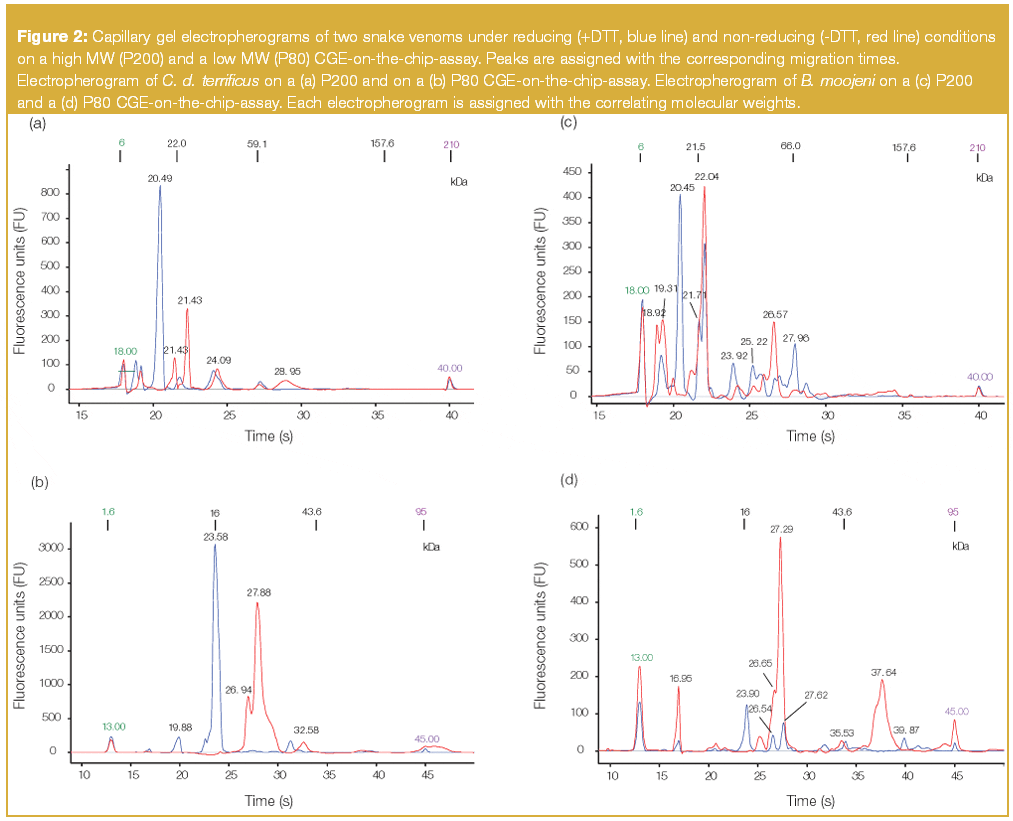The Saga of the Electron-Capture Detector
LCGC Europe
In addition to the universal detectors used in gas chromatography (GC), selective detectors have also played an important role in the rapid spreading of the utilization of the technique. Probably the most important selective GC detector is the electron-capture detector, with a very high sensitivity to organic compounds containing chlorine and fluorine atoms in their molecules. The electron-capture detector had a vital role in environmental protection and control - its use helped to prove the ubiquitous presence of chlorinated pesticides in nature and halocarbons in our atmosphere, and made us aware of the global extent of pollution. It was the electron-capture detector that made concentration ranges of parts-per-billion (ppb: 1:109) or even parts-per-trillion (ppt: 1:1012) detectable. Today, these terms are used routinely without realising how formidable such a sensitivity really is: 1 ppb means that a spaceship (or a UFO, depending upon one's inclination) could pick up a particular family of six from..
In addition to the universal detectors used in gas chromatography (GC), selective detectors have also played an important role in the rapid spreading of the utilization of the technique. Probably the most important selective GC detector is the electron-capture detector, with a very high sensitivity to organic compounds containing chlorine and fluorine atoms in their molecules. The electron-capture detector had a vital role in environmental protection and control — its use helped to prove the ubiquitous presence of chlorinated pesticides in nature and halocarbons in our atmosphere, and made us aware of the global extent of pollution. It was the electron-capture detector that made concentration ranges of parts-per-billion (ppb: 1:109 ) or even parts-per-trillion (ppt: 1:1012 ) detectable. Today, these terms are used routinely without realising how formidable such a sensitivity really is: 1 ppb means that a spaceship (or a UFO, depending upon one's inclination) could pick up a particular family of six from the whole living population of the Earth, and 1 ppt means that it could even find a piece of chewing gum in the pocket of one of the children. Lovelock — the inventor of the electron-capture detector — illustrated its superior sensitivity by the following metaphor: If one would pour about a litre of a perfluorocarbon liquid onto a blanket in Japan and left it out to dry in the air by itself, a few weeks later one could detect on the west coast of England the vapour that had evaporated into the air in Japan from that blanket and carried by the jet stream around the world.1
The electron-capture detector is an ionization detector and its response is based upon the ability of molecules with certain functional groups to capture electrons generated by the radioactive source. The detector chamber contains two electrodes and a radioactive foil as the radiation source. Using an inert carrier gas with no affinity for electrons, the ions formed by the ionizing radiation can be collected, creating a steady standing current in the detector. When molecules of certain electron-absorbing solutes enter the detector chamber, they will capture electrons, resulting in a decrease of the standing current, giving a negative peak. In practice, the recorded peaks are made positive by reversing the polarity of the recorder.
Since its invention, the design of the electron-capture detector has undergone a number of changes, but its principles have remained the same, as shown in Figure 1. Also, different radioactive sources have been used: in Lovelock's original design, the foil contained 90 Sr, but soon this was changed to tritium occluded in titanium foil. Today, it almost universally contains 63 Ni. However, questions regarding the detector's construction are not our subject.
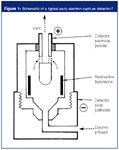
Figure 1
James E. Lovelock (born in 1919) graduated in 1941 as a chemist from Manchester University (Manchester, UK) and, in 1948, obtained his PhD in medicine from the London School of Hygiene (London, UK). After 1941, he was associated with the British Medical Research Council for almost 20 years. From 1958 to 1959, he was a visiting scientist at Yale University Medical School, New Haven, Connecticut, USA. Then, from 1960 to 1964, he was associated with Baylor College of Medicine (Houston, Texas, USA) and the University of Houston (Houston, Texas) as a professor. Since 1964, he has been a freelance scientist serving as a consultant to various companies and institutions; among others, he also cooperated in NASA's space programs. In the early 1970s, Lovelock proposed his theory of Gaia, the living Earth, functioning as a superorganism in which the physical environment and the lifeforms inhabiting the planet interact, maintaining a more-or-less steady state. His fundamental contributions to our understanding of the impact of environmental pollution were recognized by three major awards — the Heineken Prize for the Environment of the Royal Dutch Academy of Sciences (1991), the VOLVO Prize (1996) and the Blue Planet Prize (1997), which is generally considered as the environmental equivalent of the Nobel Prizes.
Lovelock has written a number of autobiographical treatments1,3,4 in which he dealt in detail with his involvement in GC and the invention and development of the electron-capture detector.
Inventions
The electron-capture detector was actually invented by Lovelock in four stages: around 1948, 1954–1955, 1956–1957 and finally in 1959. In the first two stages, the aim of his work was something else; and the electron-capturing effect obtained was unexpected and at first not understood. In the third stage, the development of the argon-ionization detector, the crucial phenomenon was not an electron-capturing effect, and only the fourth stage was aiming directly at the development of the electron-capture detector. These represent a fascinating story, illustrating how a scientist gradually perfects his work.
First stage — an anemometer: At the British Medical Research Council, Lovelock was seconded to its Common Cold Research Unit. The Unit aimed to find reasons for the common cold and Lovelock's task was to investigate the validity of the common belief that draughts of cold air can cause the illness. Scientists always try to express variables in quantitative terms, and thus, air movements are to be expressed in terms of velocity. However, air movement due to drafts in a closed room is so slight that the then existing anemometers could not detect, even less measure it. Therefore, Lovelock invented a new anemometer that was based upon the disturbance of the slow flow of positive ions produced by the radiation from radium by even very slight air flow. He obtained radium by scraping the dial paint from some gauges taken from the flight deck of a World War II military aircraft, ashing it, suspending the ash in a lacquer and painting with it the anemometer's ion source, which was surrounded by three wire circles in an open sphere and served as the collector of ions. This device worked well as an anemometer; in fact, it was sensitive not only to small air flows but even to the slightest cigarette smoke in the atmosphere. Lovelock also investigated whether other gases cause similar disturbance and found, among other things, that very small concentrations of halocarbons also result in a similar response. In other words, his anemometer acted as an electron-capture detector although the reason for this behaviour was not clear. At that time no one was interested in this observation and the device was too sensitive for use as an anemometer. Thus, while Lovelock described it in a short paper,5 no further work was done with it.
Second stage — the search for a high-sensitivity detector: In 1951, Lovelock was transferred to the National Institute for Medical Research (NIMR) of the Council (London, UK). There he was involved in another type of research in which he needed to determine the composition of the lipids in the membrane of a living cell. Close to Lovelock's laboratory was the laboratory of A.J.P. Martin and A.T. James, who were working on the adaptation of partition chromatography — invented in 1941 by Martin and R.L.M. Synge6 — to systems permitting the separation of volatile compounds, using an inert gas as the mobile phase, in other words, gas–liquid partition chromatography. They illustrated its possibility through the separation of volatile fatty acids.7 Lovelock asked for their help and soon a close collaboration was established between them.
Originally, James and Martin used titration to measure the eluted fatty acids and then Martin developed a gas density balance to serve as a general purpose GC detector. However, he soon found out that it was not sensitive enough and was too complicated to be operated by an average chemist. (A description of the detector8 was published only a few years after its actual development). Therefore, Martin suggested to Lovelock that he invent a more sensitive detector. While he was working on this problem, he heard about a new GC detector invented by associates of two Shell research laboratories: Otvos and coworkers at the Shell Development laboratories (Emeryville, California, USA)9,10 and Boer at the Koninklijke/Shell laboratory (Amsterdam, The Netherlands).11 This detector was based upon the ionization of molecules by β-ray using 90 Sr as the radiation source. Lovelock immediately tried to build one; but he had a problem with the carrier gas. Both Otvos and Boer used the light gases hydrogen and helium, but these two could not be used at the NIMR as helium was prohibitive due to its high price and hydrogen was unacceptable for safety reasons. So Lovelock tried to work with nitrogen, but his first results were discouraging — the sensitivity of the device did not meet their requirements. At that time, Lovelock remembered his experience with the anemometer, the sensitivity of which was very dependent upon the applied potential and, thus, tried to use different ranges with the new detector to find out whether the results can be improved. Indeed, when using low potentials, he suddenly obtained dozens of large peaks when analyzing allegedly pure substances, but their retention times differed from the values the compound's peak should have had. In fact, what he now had was an electron-capture detector and the large peaks were due to trace quantities of electron-absorbing impurities in the sample.
In his recollections,4 Lovelock describes an interesting and most annoying observation during his investigations. One of the samples he tried out on the new detector was dissolved in carbon tetrachloride, which was considered to be an unreactive solvent. However, upon injection, the ion current fell to zero and no further peak could be observed. In fact, it remained there for weeks and all attempts to restore the detector's operation failed. Only much later did he realize CCl4 is one of the most intensely electron-absorbing substances. Part of the vapours that exited the column became adsorbed on the silicone rubber seal between the column and the detector in his homemade GC. In fact, this amount of CCl4 slowly desorbing into the column effluent became an almost permanent source of its vapour, making the use of the detector useless for weeks. As he said, they had no use for such a temperamental detector that at the time seemed to be useless for their purpose, so it was shelved and no results were published.
It is difficult to set exactly the dates of these developments. Martin certainly developed the gas-density balance detector by 1954 and Lovelock had to start looking for a more sensitive detector soon after this time. Most likely, he tried to use the modified version of the Shell detector around the year 1955 and had the argon incident, mentioned in the following, in 1956, leading to the argon-ionization detector.
Third state — the argon-ionization detector: The development of this detector is part of the series of events leading to the electron-capture detector, and therefor should be summarised briefly here. While Lovelock was continuing his investigations aiming the construction of a universal, sensitive detector, utilizing the principles of ionization, an unexpected event occurred. The Institute's store was temporarily out of nitrogen, but a flask of argon was available and, not wanting to wait until a new shipment of nitrogen arrived, Lovelock tried to use argon as the carrier gas. Applying a fairly high potential suitable to ionize the solute molecules, he indeed obtained the desired results: large peaks for the sample components and a good, noise-free baseline. When the new nitrogen shipment arrived, he tried the same conditions with that carrier gas, but the results were poor, showing only unsatisfactory low sensitivity.
Further studies revealed that the reason for the unexpected results was the so-called Penning effect. In 1934, F.M. Penning of Philips (Eindhoven) discovered that when rare gas (argon) atoms are exposed to radiation, the formed metastable atoms have a relatively long life and their concentration approaches that of the ions during steady irradiation. If traces of the vapours of some other gases are present, the metastable argon atoms transfer their energy on collision with these molecules, as long as the ionization potential of the other molecule is less than the energy level of the metastable argon atoms.12 The ions so formed yield an increased cell current related to the concentration of the other vapour in the detector chamber. So the argon-ionization detector was invented due to a lucky coincidence.
The argon-ionization detector was first discussed publicly by Lovelock in 1957 at an informal meeting of the newly formed Gas Chromatography Discussion Group (Oxford, UK) and then described in two publications.13,14 It was commercialized almost immediately by the UK-based instrument company W.G. Pye & Co., which introduced the so-called argon chromatograph at the Second International GC Symposium held in May 1958 in Amsterdam.
In the spring of 1958, Lovelock was invited to present a paper on the argon-ionization detector at the symposium Analysis of Mixtures of Volatile Substances organized 10–11 April in New York City, USA, by the New York Academy of Sciences.15 There he met S. R. Lipsky, professor at Yale University Medical School. Lipsky already built an ionization detector based upon the Shell design, but had problems with it and, after Lovelock's lecture, asked his advice. At the conclusion of their discussion, Lipsky invited Lovelock to stay for several months as a visiting professor at Yale.
Lovelock arrived at Yale soon after the Second International GC Symposium was held in May 1958 in Amsterdam, where M.J.E. Golay presented his fundamental paper on open-tubular (capillary) columns16 and Lipsky, who at that time had been carrying out investigations trying to separate saturated and unsaturated fatty acids (involved in the development of arteriosclerotic heart disease), immediately wanted to use these columns with their superior separation capability. However, due to the small sample capacity of these columns, the GC system would have needed a high-sensitivity detector and Lovelock's argon-ionization detector was an obvious choice, except that the volume of its original construction was too large for the low flow-rates used with these columns. Therefore, Lovelock redesigned it, making a small-volume version.17 Using the low-volume argon-ionization detector and high-resolution capillary columns, they soon were able to accomplish important separations of long-chain saturated and unsaturated fatty acids (as their methyl esters). After a presentation at the 134th National American Chemical Society Meeting held in September 1958 in Chicago, Illinois, USA, they submitted two papers reporting on their results, showing among others the first time the separation of methyl oleate from its trans isomer methyl elaidate.18,19
Toward the year's end Lovelock also visited A. Zlatkis at the University of Houston (Texas), taking with him the low-volume argon-ionization detector, which they used with a capillary column for the separation of petroleum products. Their first chromatogram was obtained on 6 November, 1958, in the presence of a number of visitors who signed it (Figure 2). A more complex chromatogram containing the peaks of 25 C5–C8 paraffins and cycloparaffins was included in a short paper submitted within one month to Analytical Chemistry.21
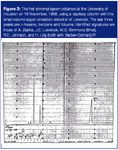
Figure 2
The chromatograms included in these publications by Lovelock, Lipsky, and Zlatkis were the first to show the superior performance of capillary columns after the fundamental paper of Golay presented at the Amsterdam Symposium.
Soon after W. G. Pye & Co., other instrument companies also added the AID to their GCs. For a few years, this detector had been widely used, mainly among biochemists, however, it was soon replaced by the flame-ionization detector first described almost simultaneously with the argon-ionization detector22,23 — the flame-ionization detector proved itself to be simpler to operate and had a wider linear range. Today, the argon-ionization detector is almost forgotten.
Fourth state — the invention of the electron-capture detector: In New Haven, Lovelock finally had time to return to his observations related to the electron-capturing effect of some molecules containing certain functional groups, and together with Lipsky, reduced the design of the electron-capture detector to practice. He also was helped by Ken McAffee, of Bell Telephone Laboratories, suggesting an improvement of the original electrical system of the detector. Their manuscript dealing with the principles and construction of the detector was finally submitted on May 14, 1959, to the Journal of the American Chemical Society and published in January 1960.24 This paper is generally cited when speaking about the electron-capture detector and its applications. However, most likely, very few people actually read it, mainly because it does not mention its particular sensitivity to compounds with certain functional groups. The paper suggests its use as a device for qualitative analysis: identification of certain compounds or compound groups. The suggested technique was to increase the applied potential gradually, decreasing in this way the electron capturing effect of individual compounds, until a saturation current was reached. At this point, electron capturing by the particular compound or compound group becomes virtually nonexistent, and the corresponding peaks disappear. Then, if the potential is increased further, the response becomes positive. As pointed out in the paper, the potential at which this transition occurs can be used for the characterization of the major classes of organic compounds.
Commercial Realization of the Electron-Capture Detector
Major instrument companies started to introduce electron-capture detectors for their GC systems around late 1961 through the early part of 1962. While in Houston, Lovelock also partnered with Al Zlatkis, forming the small company Ionics Research, producing such detectors for commercial use (Figure 3). For a few years, they supplied the detectors for the instruments of the Perkin-Elmer Corporation. However, the early detectors were fairly delicate to use and author Leslie S. Ettre remembers they often had to call them in Houston to straighten out some problems. A general complication for customers was that the detectors had radioactive material requiring a special licence to use them. Also, at the very beginning, the field of application of the detector was not clear: it only gradually became the most important device in the environmental movement, and such applications first had to be demonstrated. In this respect, Keene Dimick, the founder of Wilkens Instrument and Research Co. (the present-day Chromatography Division of Varian) and the editor of the company's quarterly publication called Aerograph Research Notes, was particularly successful. The title page of its Summer 1962 issue was particularly striking: it showed a single peak of a pesticide corresponding to 10–12 g, with the headline "Have you ever seen a picogram?" printed in large, bold-faced characters. Figure 4 shows a similar publicity chromatogram from Perkin-Elmer, demonstrating the analysis of the extract of an earthworm, indicating the presence of five pesticides.25
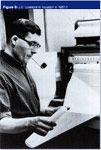
Figure 3
Electron-Capture Detection and the Environmental Movement
In general, the start of the environmental movement is identified with the publication of the book Silent Spring by Rachel Carson, in 1962,26 documenting the detrimental influence of pesticides on the environment. Its title refers to the result of their indiscriminate use with these chemicals passing from one organism through the links of the food chain (see Figure 4), eventually poisoning the wild birds and silencing the forests and meadows.
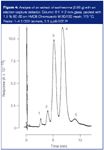
Figure 4
In the literature, one can often find implications that Carson's book was made possible by the use of the electron-capture detector and even a relatively recent New York Times article expressed this opinion, saying Lovelock's invention was "providing a foundation for the work of Rachel Carson".27 This is, however, not true — Silent Spring was based upon investigations in the 1950s using other analytical techniques, and this is clear if one checks the more than 500 literature references given in the book. However, it is true that the use of the electron-capture detector provided the infallible proof of the correctness of Carson's conclusions. Lovelock cites the first two papers reporting on the use of the electron-capture detector for the determination of pesticide residues — the first was a presentation by British scientists from Shell at the 18th International Congress on Pure and Applied Chemistry, in August 1961, in Montreal, Canada,28 and the other by associates of the USA Food & Drug Administration (FDA) presented at the 75th Annual Meeting of the Association of Official Agricultural Chemists, held in October 1961 in Washington, DC, USA.29

The Chlorofluorocarbon Problem
There is one major field where Lovelock's personal activities have served as the foundation of our awareness of the detrimental effect of air pollution and eventually led to banning the use of halocarbons. We should finish our discussion with a brief summary of these activities.
In 1966, Lovelock and his family spent the summer on the west coast of Ireland and was surprised to often see haze over the bay, depending upon the wind. The next summer, when returning to Ireland, he brought with him a portable GC system and regularly measured the chlorofluorocarbon Freon F11 (trichlorofluoro-methane) — the most widely used halocarbon — concentration during and after the outbreak of hazy air. His measurements clearly established on clear days the presence of a small steady background concentration of about 50 ppt, which increased by threefold in the case of a haze. This increase easily could be attributed to pollution brought by winds from the European continent; however, there was no explanation for the steady background concentration on clear days when the winds came from the Atlantic Ocean — did this mean the air was polluted there? To investigate this, in November 1971, Lovelock joined the Research Ship Shackleton of the British Natural Environment Research Council for a six-month voyage travelling from England to Antarctica to carry out measurements of atmospheric halocarbon concentration over the Atlantic Ocean. The results of these measurements30 clearly indicated the accumulation of Freon 11 (and other halocarbons) used in aerosol cans and as refrigerant in the Earth's atmosphere, serving as the source of the steady background concentration he observed on the Irish coast. Lovelock's data collected during this voyage have served as the basis on which F.S. Rowland and M. Molina were able to develop their theory on the decomposition of the halocarbons in the stratosphere, releasing chlorine that in turn, is catalysing the depletion of stratospheric ozone.31 For their work, Roland and Molina (together with P. Crutzen, of The Netherlands) received the 1995 Chemistry Nobel Prize.
For a long time, the electron-capture detector was the most sensitive GC detector with its unique selectivity. Recent, improvements in GC–mass spectrometry systems have rivalled it. However, GC–electron-capture detection systems still remain the workhorse instruments for routine pesticide determinations in water and soil, PCBs in the transformer oils and halocarbons in air.
References
1. J.E. Lovelock, Homage to Gaia (Oxford University Press, Oxford, 2000) pp.181–190.
2. L.S. Ettre, J. Chromatogr. Sci., 16, 396–417 (1978).
3. J.E. Lovelock, L.S. Ettre and A. Zlatkis, Eds., 75 Years of Chromatography — A Historical Dialogue (Elsevier, Amsterdam), pp. 277–284.
4. J.E. Lovelock, in Electron Capture Theory and Practice in Chromatography, A. Zlatkis and C. F. Poole, Eds. (Elsevier, Amsterdam, 1981), pp. 1–11.
5. J.E. Lovelock and E.M. Wasilewska, J. Sci. Instrum., 26, 367–370 (1949).
6. A.J.P. Martin and R.L.M. Synge, Biochem. J., 35, 1358–1368 (1941).
7. A.T. James and A.J.P. Martin, Biochem. J., 50, 679–690 (1952).
8. A.J.P. Martin and A.T. James, Biochem. J., 63, 138–142 (1956).
9. J.W. Otvos and D.P. Stevenson, J. Am. Chem. Soc., 78, 546–551 (1956).
10. C.H. Deal, J.W. Otvos, W. N. Smith and P. S. Zucco, Anal. Chem. 28, 1958–1964 (1956).
11. H. Boer, Vapour Phase Chromatography (1956 London Symposium), D. H. Desty, Ed. (Butterworths, London, 1957), pp. 169–184.
12. F.M. Penning, Physica (Amsterdam), 1, 1028–1044 (1934).
13. J.E. Lovelock, Nature (London), 181, 1460–1462 (1958).
14. J.E. Lovelock, J. Chromatogr., 1, 35–46 (1958).
15. J.E. Lovelock, A.T. James and E.A. Piper, Ann. N.Y. Acad. Sci., 72, 720–730 (1959).
16. M.J.E. Golay, in Gas Chromatography 1958 (Amsterdam Symposium), D.H. Desty, Ed. (Butterworths, London, 1958), pp. 36–55).
17. J.E. Lovelock, Nature (London), 182, 1663–1664 (1958).
18. S.R. Lipsky, R.A. Landowne, and J.E. Lovelock, Anal. Chem., 31, 852–856 (1959).
19. S.R. Lipsky, J.E. Lovelock, and R.A. Landowne, J. Am. Chem. Soc., 81, 1010 (1959).
20. L.S. Ettre, Anal. Chem., 57, 1419A–1438A (1985).
21. A. Zlatkis and J.E. Lovelock, Anal. Chem. 31, 620–621 (1959).
22. I. G. McWilliam and R.A. Dewar, Nature (London), 181, 760 (1958).
23. I.G. McWilliam and R.A. Dewar, in Gas Chromatography 1958 (Amsterdam Symposium), D.H. Desty, Ed. (Butterworths, London, 1958), pp. 142–152.
24. J.E. Lovelock and S.R. Lipsky, J. Am. Chem. Soc., 82, 431–433 (1960).
25. E.W. Cieplinski, Instrument News 15(2), 7–8 (1964).
26. Rachel Carson, Silent Spring (Houghton Mifflin Co., New York. 1962), 7th printing: 1994.
27. A.C. Revkin, The New York Times Science Section, September 12, 2006.
28. E.S. Goodwin, R. Golden, and J.G. Reynolds, Analyst, 86, 697–709 (1961); 87, 169 (1962).
29. J.O. Watts and A.K. Klein, J. Assoc. Off. Agr. Chem., 45, 102–198 (1962).
30. J.E. Lovelock, R.J. Maggs, and R.J. Waade, Nature (London) 241, 194–196 (1973).
31. F.S. Rowland and M.J. Molina, Rev. Geophys. Space Phys. 13, 1–36 (1975).
Dr Peter J.T. Morris is manager of research and residencies at the Science Museum, in London, UK. He is an Oxford University graduate and has published on many aspects of modern chemistry, including chromatography.
Dr Leslie S. Ettre was associated with the Chemical Engineering Department of Yale University (New Haven, Connecticut) from 1988 to 2004, first as an adjunct professor and then as a research fellow. Previously, he had been with the Perkin-Elmer Corporation for 30 years and is currently a member of LC•GC Europe's editorial advisory board.

Study Examines Impact of Zwitterionic Liquid Structures on Volatile Carboxylic Acid Separation in GC
March 28th 2025Iowa State University researchers evaluated imidazolium-based ZILs with sulfonate and triflimide anions to understand the influence of ZILs’ chemical structures on polar analyte separation.
Advances in Non-Targeted Analysis for PFAS in Environmental Matrices
March 27th 2025David Megson from Manchester Metropolitan University in Manchester, UK, spoke to LCGC International about the latest developments in non-targeted analysis (NTA) of per- and polyfluoroalkyl substances (PFAS) in environmental matrices based on a recent systematic review paper he has collaboratively published (1).




